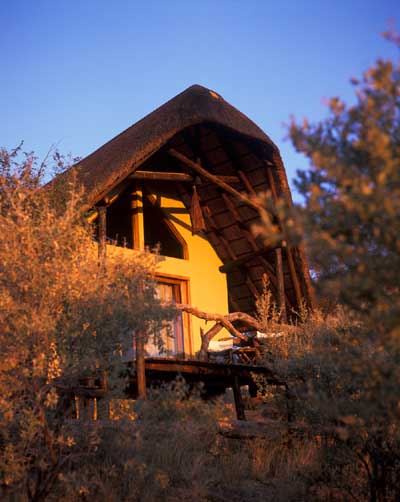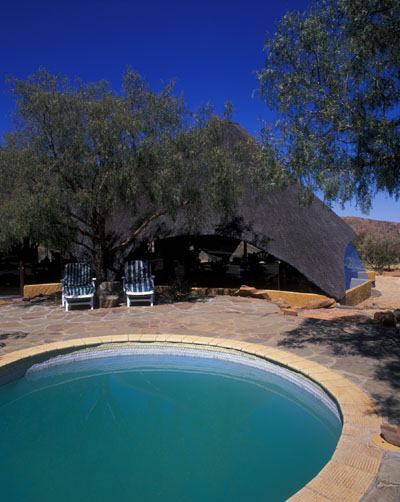The Observatory before
moving to Skinakas / Die
Sternwarte vor dem Umzug nach Skinakas
Location / Standort
|
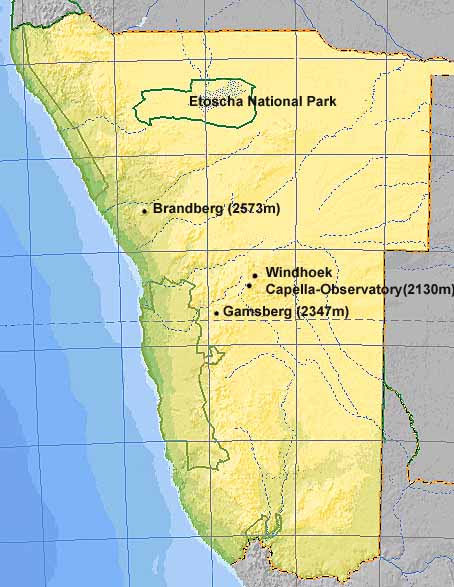
|
The Capella-Observatory is located about
20km southwest of Windhoek (Namibia) at the Kupferberg (Cooperhill), about 2100
m above sea level.
The nearness to Windhoek results in a light polluted sky to the North East direction,
but to the South direction the sky is as black as a hole. First experiences show,
that the seeing, which is so important for astronomical images, is moderate
(2.5" FWHM) to good (1.5" FWHM). Until now, we have no experiences with the
seeing in the "cold season" (May-August), but we hope to have even better
values.
Das Capella-Observatory befindet sich ca. 20km südwestlich
von Windhoek (Namibia) auf dem Kupferberg, etwa 2100 Meter über dem
Meeresspiegel. Die Nähe zu Windhoek hat zwar einen in
Richtung Nordosten aufgehellten Himmel zur Folge, Richtung Süden aber ist
der Himmel sprichwörtlich "schwarz wie die Nacht". Das für gute
Astro-Aufnahmen so wichtige Seeing ist nach ersten Erfahrungen mal mäßig
(2.5" FWHM), mal gut (1.5"FWHM). Noch liegen hier keine Erfahrungen für die
"kalte Jahreszeit" (Mai-August) vor, wir hoffen aber auf noch bessere Werte.
The Coordinates / Die Koordinaten des Standortes:
22°43´57,91" South, 16°58´54,69" East
|
Amani-Lodge
The observatory is located at the Amani-Lodge,
a beautiful place (the highest inhabited location in Namibia!) which offers the
suitable surroundings for relaxation and "adventure" after an astronomer's night
shift. Where else do you have the chance to visite a cheetah right after
breakfast?! Alain - one of the few Frenchmen in Namibia - is an
extraordinary host and it is always worth to visite Amani Lodge when you are
close to the area.
Die Sternwarte befindet sich auf der Amani-Lodge, einem
zauberhaften Anwesen (dem höchtgelegenen in Namibia!), das nach durchwachter
Nacht das nötige Ambiente für Entspannung und "Abenteuer" liefert. Wo sonst hat
man schon die Gelegenheit, nach dem Frühstück einen Geparden zu besuchen?!
Alain - einer der wenigen Franzosen in Namibia - ist ein außerordentlich netter
Gastgeber und ein Besuch dieser Lodge lohnt sich sicher für jeden, der einmal in
dieser Gegend sein sollte.
More Information about the Amani-Lodge
can be found here:
/ Nähre Informationen zur Amani-Lodge finden Sie hier:
http://www.amani-lodge-namibia.com
The Building / Das Gebäude
The Observatory is a solid building, which
consists of two rooms: the control room and the observation room. The roof
of the observation room can be shifted away on iron wheels. When
the roof is open, the control room still remains closed so that no unnecessary turbulent
air (from the observers and the PCs) makes worse the seeing. A room
size of about 15 m² for the observation room and 8 m² for the control room are not
overwhelming but o.k. for a comfortable working.
A 1 m³ cube of concrete serves as a base for
the telescope. This cube is placed in the base plate of the observation room
and is decoupled mechanically from it, so that no vibrations of the building are
transferred to the telescope.
The open cut of the observatory has the
advantage, that the dome seeing is not a problem. But it has a
disadvantage also: since the telescope is outdoor during observation, the wind
may affect it. The wind at this level (more than 2100 m) somtimes is
very strong and may shake even the strongest mount which may result in a camera
shake (even if only 1" to 2"). A solution was found by adding some wind shields,
which can be fixed to the inside of the walls when needed.
Das Sternwartengebäude ist ein Massivbau, der aus zwei Räumen
besteht: einem Kontroll- und dem eigentlichen Beobachtungsraum. Auch bei
geöffnetem Dach ist der Kontrollraum geschlossen, so dass keine unnötige
Luftunruhe durch die Abwärme von Beobachtern und PCs das Seeing verschlechtert.
Ca. 15 m² Fläche für den Beobachtungsraum und 8 m² für den Kontrollraum sind
zwar nicht gewaltig, reichen aber doch für ein sehr bequemes "Arbeiten".
Als Fundament für das Teleskop dient ein 1 m³ großer
Beton-Sockel, der in die Bodenplatte des Beobachtungsraumes eingelassen und von
dieser mechanisch entkoppelt ist, so dass sich Schwingungen des Gebäudes nicht
auf das Teleskop übertragen.
Beim Dach handelt es sich um eine einfache Rolldachkonstruktion.
In geöffnetem Zustand befindet sich das Rolldach größtenteils als "Zweitdach" über
dem Kontrollraum.
Die offene Bauweise der Sternwarte hat den Vorteil, dass das
gefürchtete Kuppelseeing kein Problem darstellt. Es hat allerdings auch einen
Nachteil: Da das Teleskop während der Beobachtung im Freien steht, ist es dem
Wind ausgesetzt, der in dieser Höhe (immerhin über 2100 m) schon mal ganz
kräftig blasen kann und der selbst bei noch so stabilen Montierungen ein
Verwackeln (wenn auch nur um 1-2 Bogensekunden) zur Folge haben kann. Abhilfe schufen
hier Windfänger, die bei Bedarf von innen an den Wänden des Beobachtungsraums
befestigt werden können.
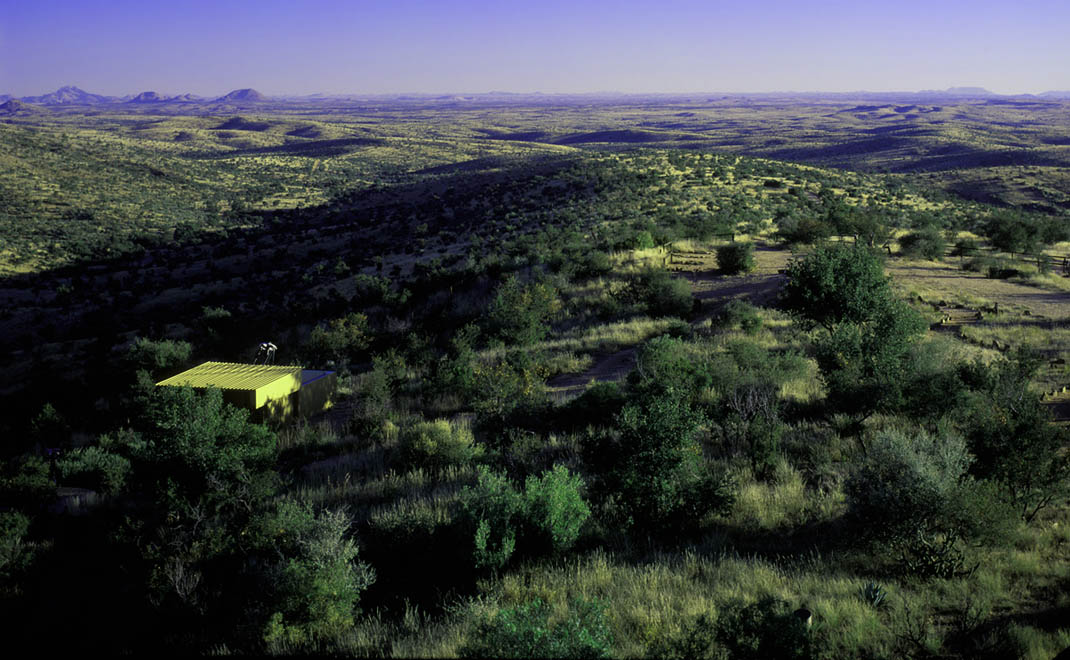 |
|
The opened building photographed during sun set. As you
can see, it is located at the edge of a small hill. This position not
always proofs to be the very best, since wind coming from the east (behind) blows
strongly over the observatory.
Das geöffnete Gebäude,
photographiert während des Sonnenuntergangs. Wie man sieht, befindet
es sich am Rande eines Hügels, was sich als nicht immer optimal
herausgestellt hat, da Wind, der aus dem Osten (von hinten) kommt, kräftig
über das Observatorium hinweg bläst. |
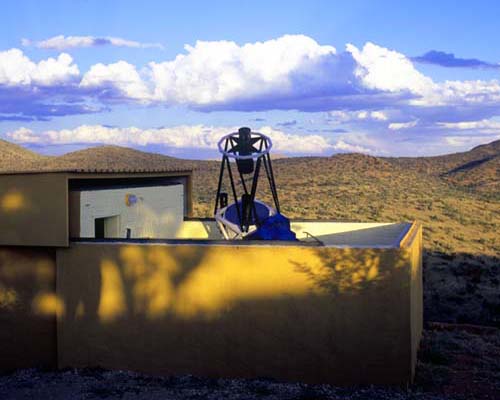 |
|
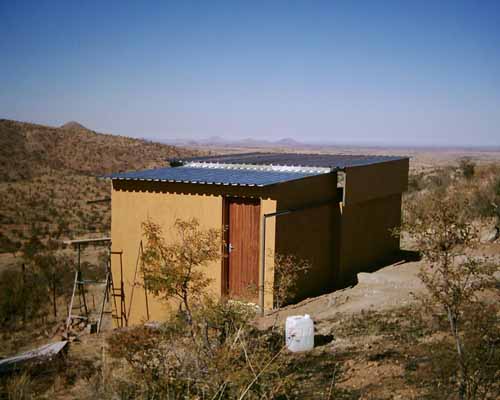
|
|
|
|
|
|
The building with the roof opened. Das Gebäude
mit geöffnetem Dach.
|
|
The building with the roof
closed. As you can see, the building was not completely finished, when this
photo was taken. The gap on the right side between the fixed and the moving
part of the
roof was not closed at that time. Das Gebäude mit geschlossenem
Dach. Wie Sie sehen, war das Gebäude zum Zeitpunkt der Aufnahme noch nicht
komplett fertiggestellt. Die Öffnung auf der rechten Seite zwischen dem
bewegten und dem unbewegten Teil des Daches war zu dieser Zeit noch offen. |

